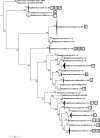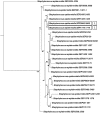Bacteriocins of Non-aureus Staphylococci Isolated from Bovine Milk
- PMID: 28667105
- PMCID: PMC5561277
- DOI: 10.1128/AEM.01015-17
Bacteriocins of Non-aureus Staphylococci Isolated from Bovine Milk
Abstract
Non-aureus staphylococci (NAS), the bacteria most commonly isolated from the bovine udder, potentially protect the udder against infection by major mastitis pathogens due to bacteriocin production. In this study, we determined the inhibitory capability of 441 bovine NAS isolates (comprising 26 species) against bovine Staphylococcus aureus Furthermore, inhibiting isolates were tested against a human methicillin-resistant S. aureus (MRSA) isolate using a cross-streaking method. We determined the presence of bacteriocin clusters in NAS whole genomes using genome mining tools, BLAST, and comparison of genomes of closely related inhibiting and noninhibiting isolates and determined the genetic organization of any identified bacteriocin biosynthetic gene clusters. Forty isolates from 9 species (S. capitis, S. chromogenes, S. epidermidis, S. pasteuri, S. saprophyticus, S. sciuri, S. simulans, S. warneri, and S. xylosus) inhibited growth of S. aureus in vitro, 23 isolates of which, from S. capitis, S. chromogenes, S. epidermidis, S. pasteuri, S. simulans, and S. xylosus, also inhibited MRSA. One hundred five putative bacteriocin gene clusters encompassing 6 different classes (lanthipeptides, sactipeptides, lasso peptides, class IIa, class IIc, and class IId) in 95 whole genomes from 16 species were identified. A total of 25 novel bacteriocin precursors were described. In conclusion, NAS from bovine mammary glands are a source of potential bacteriocins, with >21% being possible producers, representing potential for future characterization and prospective clinical applications.IMPORTANCE Mastitis (particularly infections caused by Staphylococcus aureus) costs Canadian dairy producers $400 million/year and is the leading cause of antibiotic use on dairy farms. With increasing antibiotic resistance and regulations regarding use, there is impetus to explore bacteriocins (bacterially produced antimicrobial peptides) for treatment and prevention of bacterial infections. We examined the ability of 441 NAS bacteria from Canadian bovine milk samples to inhibit growth of S. aureus in the laboratory. Overall, 9% inhibited growth of S. aureus and 58% of those also inhibited MRSA. In NAS whole-genome sequences, we identified >21% of NAS as having bacteriocin genes. Our study represents a foundation to further explore NAS bacteriocins for clinical use.
Keywords: Staphylococcus; Staphylococcus aureus; bacteriocins; cattle; coagulase-negative staphylococci; mastitis.
Copyright © 2017 American Society for Microbiology.
Figures










Similar articles
-
Prevalence of non-aureus staphylococci species causing intramammary infections in Canadian dairy herds.J Dairy Sci. 2017 Jul;100(7):5592-5612. doi: 10.3168/jds.2016-12478. Epub 2017 May 17. J Dairy Sci. 2017. PMID: 28527793
-
Distribution of non-aureus staphylococci species in udder quarters with low and high somatic cell count, and clinical mastitis.J Dairy Sci. 2017 Jul;100(7):5613-5627. doi: 10.3168/jds.2016-12479. Epub 2017 Apr 27. J Dairy Sci. 2017. PMID: 28456402
-
Genomic Analysis of Bacteriocin-Producing Staphylococci: High Prevalence of Lanthipeptides and the Micrococcin P1 Biosynthetic Gene Clusters.Probiotics Antimicrob Proteins. 2025 Feb;17(1):159-174. doi: 10.1007/s12602-023-10119-w. Epub 2023 Aug 26. Probiotics Antimicrob Proteins. 2025. PMID: 37632676 Free PMC article.
-
Non-aureus staphylococci and mammaliicocci (NASM): their role in bovine mastitis and One Health.J Dairy Res. 2024 Feb;91(1):44-56. doi: 10.1017/S0022029924000165. Epub 2024 Apr 8. J Dairy Res. 2024. PMID: 38584301 Review.
-
Staphylococcal mastitis in dairy cows.Front Vet Sci. 2024 May 28;11:1356259. doi: 10.3389/fvets.2024.1356259. eCollection 2024. Front Vet Sci. 2024. PMID: 38863450 Free PMC article. Review.
Cited by
-
Horizontal Transfer of Bacteriocin Biosynthesis Genes Requires Metabolic Adaptation To Improve Compound Production and Cellular Fitness.Microbiol Spectr. 2023 Feb 14;11(1):e0317622. doi: 10.1128/spectrum.03176-22. Epub 2022 Dec 6. Microbiol Spectr. 2023. PMID: 36472430 Free PMC article.
-
Aloe arborescens supplementation in drying-off dairy cows: influence on rumen, rectum and milk microbiomes.Anim Microbiome. 2024 Aug 31;6(1):49. doi: 10.1186/s42523-024-00336-1. Anim Microbiome. 2024. PMID: 39217403 Free PMC article.
-
A Critical Appraisal of Probiotics for Mastitis Control.Front Vet Sci. 2018 Oct 10;5:251. doi: 10.3389/fvets.2018.00251. eCollection 2018. Front Vet Sci. 2018. PMID: 30364110 Free PMC article. Review.
-
Changes in bovine milk bacterial microbiome from healthy and subclinical mastitis affected animals of the Girolando, Gyr, Guzera, and Holstein breeds.Int Microbiol. 2022 Nov;25(4):803-815. doi: 10.1007/s10123-022-00267-4. Epub 2022 Jul 15. Int Microbiol. 2022. PMID: 35838927
-
Investigation of milk microbiota of healthy and mastitic Sahiwal cattle.BMC Microbiol. 2023 Oct 24;23(1):304. doi: 10.1186/s12866-023-03051-0. BMC Microbiol. 2023. PMID: 37875803 Free PMC article.
References
-
- De Vliegher S, Opsomer G, Vanrolleghem A, Devriese LA, Sampimon OC, Sol J, Barkema HW, Haesebrouck F, de Kruif A. 2004. In vitro growth inhibition of major mastitis pathogens by Staphylococcus chromogenes originating from teat apices of dairy heifers. Vet Microbiol 101:215–221. doi:10.1016/j.vetmic.2004.03.020. - DOI - PubMed
Publication types
MeSH terms
Substances
LinkOut - more resources
Full Text Sources
Other Literature Sources
Research Materials

